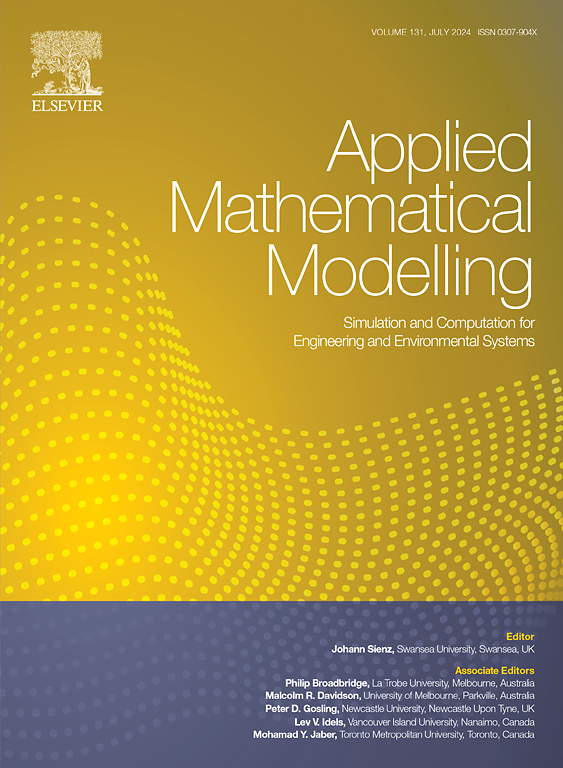基于简化PN近似的辐射相变问题简化模型
IF 4.4
2区 工程技术
Q1 ENGINEERING, MULTIDISCIPLINARY
引用次数: 0
摘要
相变介质中的辐射传热在许多涉及内部熔化或凝固的科学和工程热应用中引起了极大的兴趣。在这些高温问题中,用于描述传热和相变的数学模型还应包括考虑热辐射的方程。在这些模型中使用积分-微分方程计算辐射强度会导致一个耦合方程组,其数值解的计算要求很高。在本研究中,我们建立了一类考虑灰色热辐射的相变问题的有效简化模型。这些模型的新颖之处在于,在不求解计算要求很高的辐射传递方程的情况下,热辐射的影响在相变材料中得到了很好的捕捉。该模型由焓公式和球面谐波的简化PN近似推导而来。将全辐射传递的积分-微分方程替换为一组不依赖于角度变量且易于用常规计算方法求解的微分方程。为了求解耦合方程,我们采用二阶隐式格式进行时间积分,采用混合有限元方法进行空间离散。本文还采用了基于牛顿的算法来求解由单片方法引起的非线性系统。在二维和三维空间辐射换热与相变耦合问题的若干测试实例中,分析了所提出的简化模型的性能。本研究的结果表明,所提出的模型可以准确地预测熔化和凝固实例中的温度分布并捕获相变界面,同时保持非常低的计算成本。本文章由计算机程序翻译,如有差异,请以英文原文为准。
A reduced model for phase-change problems with radiation using simplified PN approximations
Radiative heat transfer in phase-change media is of great interest in many thermal applications in sciences and engineering involving internal melting or solidification. In these problems at high temperature, a mathematical model used to describe the heat transfer and phase change should also include equations accounting for thermal radiation. Using the integro-differential equation for the radiative intensity in these models results in a system of coupled equations for which its numerical solution is computationally very demanding. In the present study, we develop a class of efficient reduced models for phase-change problems accounting for grey thermal radiation. The novelty in these models lies in the fact that effects of thermal radiation are well captured in phase-change materials without solving the computationally demanding radiative transfer equation. The model is derived from the enthalpy formulation and the simplified approximations of spherical harmonics. The integro-differential equation for the full radiative transfer is replaced by a set of differential equations which are independent of the angle variable and easy to solve using conventional computational methods. To solve the coupled equations, we implement a second-order implicit scheme for the time integration and a mixed finite element method for the space discretization. A Newton-based algorithm is also adopted for solving the nonlinear systems resulting from the considered monolithic approach. The performance of the proposed reduced models is analyzed on several test examples for coupled radiative heat transfer and phase-change problems in two and three space dimensions. The results presented in this study demonstrate that the proposed models can accurately predict the temperature distributions and capture the phase-change interfaces in melting and solidification examples, all while maintaining a very low computational cost.
求助全文
通过发布文献求助,成功后即可免费获取论文全文。
去求助
来源期刊

Applied Mathematical Modelling
数学-工程:综合
CiteScore
9.80
自引率
8.00%
发文量
508
审稿时长
43 days
期刊介绍:
Applied Mathematical Modelling focuses on research related to the mathematical modelling of engineering and environmental processes, manufacturing, and industrial systems. A significant emerging area of research activity involves multiphysics processes, and contributions in this area are particularly encouraged.
This influential publication covers a wide spectrum of subjects including heat transfer, fluid mechanics, CFD, and transport phenomena; solid mechanics and mechanics of metals; electromagnets and MHD; reliability modelling and system optimization; finite volume, finite element, and boundary element procedures; modelling of inventory, industrial, manufacturing and logistics systems for viable decision making; civil engineering systems and structures; mineral and energy resources; relevant software engineering issues associated with CAD and CAE; and materials and metallurgical engineering.
Applied Mathematical Modelling is primarily interested in papers developing increased insights into real-world problems through novel mathematical modelling, novel applications or a combination of these. Papers employing existing numerical techniques must demonstrate sufficient novelty in the solution of practical problems. Papers on fuzzy logic in decision-making or purely financial mathematics are normally not considered. Research on fractional differential equations, bifurcation, and numerical methods needs to include practical examples. Population dynamics must solve realistic scenarios. Papers in the area of logistics and business modelling should demonstrate meaningful managerial insight. Submissions with no real-world application will not be considered.
 求助内容:
求助内容: 应助结果提醒方式:
应助结果提醒方式:


